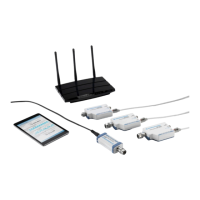Preparing for use
R&S
®
NRP Series
23Getting Started 1419.0170.02 ─ 16
2. NOTICE! Risk of sensor damage. Only use PoE power sourcing equipment
(PSE) as described in "Choose the PoE power sourcing equipment (PSE) with
care" on page 15.
Connect the RJ-45 Ethernet connector of the sensor to the output of the PoE
injector.
3. Connect the PoE injector to a power supply.
4. Connect the controlling host to the input of the PoE injector.
5. Establish a network connection between the power sensor and the controlling
host.
3.7.3.2 Establishing a connection to the network
There are two methods to establish a network connection:
●
Power sensor and controlling host are connected to a common network
(infrastructure network).
●
Power sensor and controlling host are connected only over the switch
(peer-to-peer network).
In both cases, you can address the LAN power sensor as follows:
●
Chapter 3.7.3.3, "Using hostnames", on page 24
●
Chapter 3.7.3.4, "Assigning the IP address", on page 25
To set up a network Ethernet connection
1. Connect the power sensor as described in Chapter 3.7.3.1, "Connecting a
LAN power sensor to the LAN", on page 20.
By default, the power sensor is configured to use dynamic TCP/IP configura-
tion (DHCP) and to obtain the address information automatically.
If both LAN status LEDs are illuminated in green color, the power sensor is
correctly connected to the network.
Note: Establishing a connection can take up to 2 minutes per device.
2. If the LAN status LEDs show another state, no connection is possible. For
possible solutions, see:
● "Network status LED" on page 31
● "Troubleshooting for peer-to-peer connections" on page 24
Connecting to a controlling host

